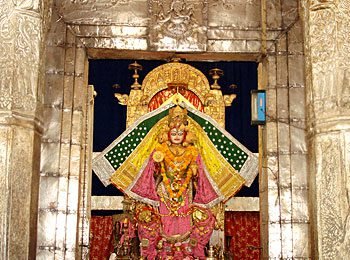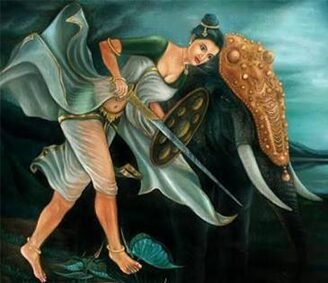Chamba Devi: The Divine Protector and Icon of Devotion

In the fabric of spirituality in India, Chamba Devi shines like an all-powerful, compassionate, protective goddess. Devotees in different regions and religions venerate her. The existence of Chamba Devi transcends physical and cultural boundaries by offering an alluring mix of mythology, history, and spirituality, each reverberating in the hearts of generations to come.
Closely associated with the town of Chamba in Himachal Pradesh, her narrations extend far beyond the geophysical limits of Chamba to paint broader hues of devotion and stability here in India. She is a local guardian and a universal symbol, a subliminal god. Temples towering in her name, festivals celebrating her, and cultures weaving her more deeply within.
History
The history of Chamba Devi is completely wrapped up in the town of Chamba, which lies in a picturesque setting in the hills of Himachal Pradesh. It was established in 920 CE by Raja Sahil Varman of the Varman dynasty and, according to folklore, named after Champavati, his daughter, with whom Chamba Devi is sometimes identified. It developed very fast as a town providing trade, art, and spirituality-cum-protection by the goddess herself.
The philanthropic rulers of Chamba, deeply religious, and cultural patrons, made many big temples and religious art pieces in Chamba Devi’s mission. Her temple in the middle of the town represents such wealth of all architectural marvels, uniting Hindu and Pahari traditions. Built out of locally available stones and wood, this temple is a marvel with many intricate carvings and murals portraying portions of her story.
Over the years, Chamba became a pilgrimage hub, serving its devotees mainly from North India. Her endearing presence made the town good and prosperous so that she wasn’t only a goddess but a symbol of joined-up culture and pride. The worship of the goddess was a cement for all the people, binding the aspirations of spirituality with their mortal lives.
Mythology
The mythology surrounding Chamba Devi is both enchanting and profound, characterized by narratives of bravery, devotion, and supernatural assistance. As per local traditions, Chamba Devi represents an incarnation of the Hindu goddess Durga, embodying the fierce aspect of Shakti. She is revered as the universal mother and a vanquisher of malevolence.
One widely recognized legend narrates how Chamba Devi played a crucial role in vanquishing a demon that threatened the region’s peace and prosperity. This demon, emboldened by his strength, unleashed turmoil throughout the land and left its inhabitants powerless. In response to their pleas for help, Chamba Devi descended from the skies with divine weapons in hand and riding her lion. A violent confrontation ensued between her and the demon, ultimately resulting in his defeat and restoring tranquillity to the area.
Another narrative connects Chamba Devi to Champavati, who was the virtuous daughter of Raja Sahil Varman. Champavati is celebrated for her wisdom and piety; she advised her father to prioritize his subjects’ welfare by constructing a temple dedicated to the goddess. After her premature death, she was sanctified as Chamba Devi, thereby solidifying her significance within the spiritual fabric of the town.
These tales transcend simple folklore; they symbolize deeper meanings such as the victory of good over evil, duty’s critical importance, and faith’s lasting power. They reaffirm Chamba Devi’s role as both protector and nurturer—a divine influence that safeguards those who devote themselves to her worship.
Cultural Significance
Chamba Devi has exerted an influence on the whole folk culture of the region that reveres her. Besides being a sacred space, the temple itself becomes a centre created for festivals, fairs, and ceremonies that unite people socially.
The Minjar Fair is one of the largest and most significant celebrations in honour of Chamba Devi, held every summer in Chamba to welcome the harvesting season. With a brilliant procession, the deity Chamba Devi walks through the streets to the sound of trumpets, drums, and minjar (tassels of silk and corn) being presented. This festival stands as a mark of gratitude offered to the Goddess, beseeching her for affluence and harmony.
Art and craft inspired by Chamba Devi are also common in this region. Her story and images have been inspiring and employed by various artists for centuries, including Pahari paintings and ornamental textile embroidery. These forms of expression act as symbols of her eternal presence in devotees’ lives by ingraining themselves in their cultural consciousness.
Spiritual Practices and Worship
Devotion and communal bonding characterize the worship of Chamba Devi. In her temple, daily observances include the offering of flowers, incense, and prasad (considered the food) and the chanting of hymns and aartis. During festivals and auspicious occasions, special ceremonies are performed, where crowds of devotees gather either to obtain healing or to be blessed with prosperity and safety.
Besides temple worship, Chamba Devi is revered in homes and communities through folk songs, storytelling, and local dances. Such practices serve not only to deepen her spiritual significance but also to perpetuate oral and cultural traditions related to her.
Chamba Devi is believed to be a protector of nature, with many of her devotees regard the forests, rivers, and mountains around her as sacred. This belief has entrenched in these peoples a deep respect for the environment, aligning spiritual practices with ecological stewardship.
Legacy and Influence Beyond Himachal Pradesh
While Chamba Devi is highly associated with the township of Chamba and its surroundings, her works extend way beyond Himachal Pradesh; she is, however, worshipped as a goddess within a wider set of parameters characterized by values and virtues that confluence through the cultures and communities thus recreating her field of this long-established pantheon of goddess worship existing in India proper.
Her legends and iconologies have reverberated in the worship of other kinds of Shakti, such as Durga, Kali, and Parvati. Their interwoven nature throws more light on her universal appeal and common spiritual ancestry that traverses Indian traditions and communities today.
The shrine dedicated to Chamba Devi has also become, as a middle point between tourism and pilgrim stroll, another accelerator for the region’s economy and cultural interplay. The fact that it stands out as an important site of religion-presumably fostering pilgrim and tourism interest is even more so because of its historical and architectural importance.
Conclusion
In Chamba Devi we have distilled an icon of protection, a boon, and a cultural symbol; the very embodiment of devotion, resilience, and community in Chamba, as well as the surrounding holiest places. History traces its beginnings to the establishment of Chamba, and beautiful epics tell of success, compassion, and her endeavour to inspire humankind.
Her temple acts as a beacon of spirituality and cultural pride, consolidating identity and belonging in soul among the worshippers-such a place where blessings are sought. With her worship, the people of Chamba and beyond recall awareness of their spiritual roots culturally, and within the environment.
In honouring Chamba Devi, we honour, therefore, not just a goddess but a symbol of a perennial divine presence that cares, nurtures, and guides humanity. The heritages of such a worthy legend inspire the power of faith to survive and shine forth magnificently beside the philosophy of enthusiasm to encompass this silly culture of holism even in spirituality and cultural traditions.


